February 2010
The Archives
-
Internet, Marketing, tourism bc
Tourism BC 2010 Online Olympics activities: #10 – Content is King
02.25.10 | Permalink | 2 CommentsWhen somebody is interested and inspired in British Columbia as a result of the games, we’d like to the person to start the planning process. And in the planning process, content is King, and details matter.
Over the last few years, our product management and content teams have done an incredible job of turning HelloBC.com into an in-depth travel planning resource. HelloBC contains information for over 100 different activity categories in 6 regions. But that wasn’t enough. Our website users told us they need more information at the community level in order to make the decision to visit.
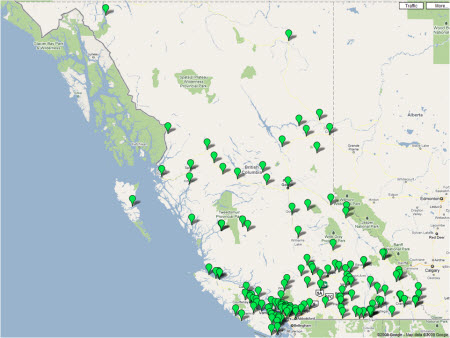
The 139 communities with in-depth content
Over the last 18 months, our content team, lead by our content Queen Mikala (also part-time indie rock groupie guru) has completed a monumental task by creating in-depth information for 139 communities across the province before the start of the games. In strong collaboration with of our regional and community partners, our writers visited 139 communities across the province, meeting with local stakeholders, touring the community and creating in depth information for HelloBC.com.
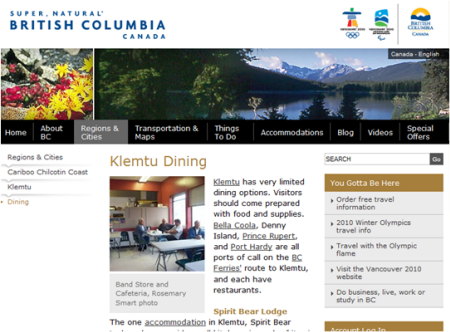
Long tail content: dining in Klemtu
The result is unprecedented. Thousands of pages of content; whether you’re interested in Cat-Skiing near Kaslo, Kermode Bear-Watching in Klemtu, mining tours in Trail, Aboriginal & Cultural experiences in Kamloops or visiting farms & Orchards near Harrison Hot Springs, the information is all there on HelloBC.
Anybody interested in BC as a result of the games will have all the information to create their BC vacation.
-
personal
My Olympic Experience #2
Yesterday I went tmy speed skating event. The 10,000 meters for men was supposed to be a guarenteed gold for the Netherlands so we were all ready for it. Well, I once against was thought there’s no sure thing in life.

-
Internet, Marketing, Travel & Tourism
Tourism BC 2010 Online Olympics activities: #9 – inspiring people new to BC
I’ve covered what we’re doing with Olympic related websites and how we drive interested people to our websites. To make sure the traffic we receive during the games is maximized we’ve worked for a long time on making the website the best it can be. The next few days are dedicated to it these activities.

Purchase cycle (well, the one we use)
HelloBC typically receives a lot of visitors who already know something about BC. In the purchase cycle, they are beyond the awareness stage and are already considering or intending to take a trip. What we’ve learned over the years is that these people are in planning mode and need information first, inspiration second. That’s why content is a huge priority for us (more about content later this week).
During the games, a lot of people will learn about BC for the first time. We call these people the newly aware. People earlier in the cycle need to learn about the destination and be inspired to visit. Everything related to the Olympics will provide a lot of inspiration and when they visit HelloBC, we’d like to continue to inspire and educate the consumer about everything BC has to offer in the process.
In order to meet the needs of the consumer in the early stages of the planning process, we created a new section for the newly aware. This section is different from the rest of the website. It contains large imagery, videos and is created in a way that encourages exploration. It was designed and created by our technology partner T4G in collaboration with Fjord West and the result is also technically interesting because it high interactivity but contains no Flash thanks to T4G’s HTML/CSS/Javascript wizz Larry.
-
Internet, Marketing, tourism bc
Tourism BC 2010 Online Olympics activities: #8 – grow our consumer database
We want to mitigate the risk that when the games are over, we’ll be out of sight, out of mind. All activities are geared towards making sure the impression we make is a big one and over the last few days I’ve shared our strategies to maximize the destination awareness and get people to start thinking about a possible visit by visiting our consumer websites.
Part of our post-games strategy is to be pro-active when the games are over and we’re putting a lot of energy into growing our consumer database. That way, we don’t have to rely on people remembering BC is great, but we can pro-actively tap them on the shoulder and remind them. Our database marketing program has evolved into sophisticated event based communication, customized to individual consumer profiles. The more consumers we can add to the database, the better guarantee for success.
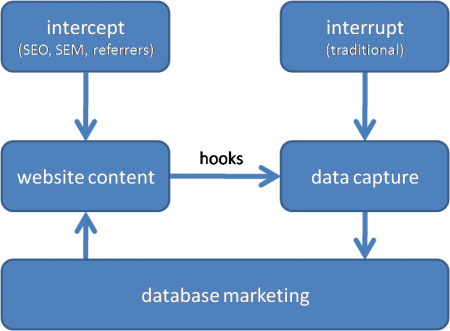
The chart above show our model for our typical approach to driving website visitation and data capture (growing our consumer database).
Intercept
Intercept tactics are targeting consumers who are specifically looking for information we provide. And in previous posts I already described some of the main activities we’re engaged in during the games; SEO/SEM and referral links. These tactics are proven to be very effective at driving highly qualified visitors.
Interrupt
Interrupt tactics are more traditional and includes things like online display advertising. These tactics aren’t necessarily targeting people who are looking for our information but target the people who fit our target audience. They might be looking for something else like medal standings and the purpose of the advertising is to get them interested in our message.
That’s why we use very direct and strong call-to-actions. In the case of the Olympics, a contest to win a trip to BC. We’ve learned that interrupt tactics aren’t the most effective at driving website visitation, but very effective at growing our consumer database (data capture).
Hooks
Intercept tactics drive a lot of qualified visitors to our website. We try to grow our consumer database by leveraging these visitors through hooks. Hooks are tactics on the website with the purpose of growing our consumer database (data capture). We run contests, offer free brochures, maps, eNewletters and more. It’s like fishing in your own pond by adding value to the consumer.
Putting it all together
We use the model above to make investment decisions. For example (note: completely fictional numbers): if it costs $25 to get add a consumer to our database through an interrupt tactic, and we add 1% of our website visitors to our database, a cost per click of $0.25 through a PPC campaign would achieve the same results from a data capture perspective. Plus we’d get 100 qualified people on the website.
Finding the right balance between all objective leads to the right investment strategy.
-
Internet, Marketing, tourism bc
Tourism BC 2010 Online Olympics activities #7: online advertising
02.20.10 | Permalink | 3 CommentsTo maximize the games, there’s a role for advertising as well. A TV commercial was produced to build the destination brand and also serves as the call to action for people watching the games and make sure consumers know where to go for more info and start the trip planning process. Consumers in the US and Canada are encouraged to visit HelloBC.com with the help of BC born celebrities (more about the commercial here).
The purpose of our online ads is not to just get people on our website, but do something very specific; grow our consumer database. The ads have a contest as a call-to-action where they can win a trip to BC this summer.

Tomorrow: our full strategy to leverage the games to grow our consumer database
-
Internet, Marketing, tourism bc
Tourism BC 2010 Online Olympics activities: #6 – SEO & SEM
02.19.10 | Permalink | 2 CommentsSearch Engines have been our biggest source of website visitation for years now. Search Engine Optimization and Marketing is also a long tail strategy. In 2009, over 500,000 unique queries drove visitors to HelloBC.com, accounting for 80% of visitors in 2009.

Still from the NBC’s opening ceremonies pre-showPeople watch TV with a computer close by. All it takes is that one beautiful shot to make somebody interested in British Columbia. And the obvious place to go when you see something and want to learn more is a Search Engine.

Search volume for the keywords ‘beijing travel’ during the 2008 gamesThe chart from Google Insights for Search above shows the increase in search volume for the keywords Beijing travel. It demonstrates the games generates increased interest in a destination and consumer behaviour on search engines. Taking advantage of this search activity to move consumers closer to a trip to BC has been one of our top priorities in our Olympic strategy.
Organic Search
We’ve been working on improving organic search traffic for a number of years and the results have paid off. Good content covering everything BC has to offer (more about in a laster post), combined with the right technical implementation has resulted in 60% increase of organic search visitors this year alone. Chances are high that something peaks somebody’s interest during the games, the organic search results will point to HelloBC.
And so far organic search has spiked significantly during the games, with daily organic search visitors more than doubling the highest organic search day last year.
Paid Search
To compliment our organic traffic, we run pay-per-click campaigns on the major search engines. A strategy was developed with our SEM agency Enquiro in Kelowna with the help from all three main search engines. PPC campaigns allow us to fill in gaps in our SEO efforts and target Olympic related keywords that meet our KPI’s in priority markets.
We maximize our large set of ad-groups containing our regular destination related keywords.Somebody who’s interested in anything BC related as a result of the games will be intercepted with one of our regular ads.
During the games, we compliment these adgroups with specific Olympic related adgroups. Those are keywords that relate directly to the games but people still might use to learn more about the destination. We’ve used the months prior to the games to fine tune our campaigns and find Olympic related keywords that meet our KPI’s. And even during the games, we monitor things closely, adjusting our campaigns on a daily basis to find the gems in Olympic searches.
-
personal
My Olympic Experience
I left our online activities for a day to take in an Olympic event myself. Sheri and I went up to Cypress Mountain to watch the snowboard halfpipe for women today. It was an incredible day. The weather was fantastic, our seats awesome and the athletes unbelievable. Torah Bright from Australia was a great winner.
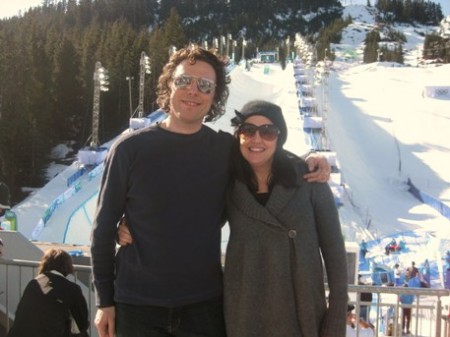
The event was perfectly organized. Staff and volunteers were incredibly friendly and helpful. The transportation by bus to the mountain was flawless. Hundreds of buses were waiting to drive people back to the transportation points. Cudos to VANOC for this one.
-
Internet, Marketing, tourism bc
Tourism BC 2010 Online Olympics activities: #5 – referral traffic
I described how we maximize exposure on Olympic related website. The next step is to drive people to our consumer website HelloBC.com where they can start planning their trip. The following chart is a conceptual diagram of our approach for driving traffic from these websites through referral links.

The Olympics are about stories. Stories related to athletes, the events and yes the host destination. The circles on the diagram represent these stories. Most are related to the sporting events and athletes (blue). But some are related to the host destination (yellow). These stories can send somebody down the path that will lead to visiting British Columbia.
We try to carry the destination stories through. Many broadcasters will run host destination vignettes on their TV broadcast. These stories are usually also posted on their website and media will often refer to their website for more info. And since the web doesn’t have a finite amount of space, there are more stories posted on websites. By offering ideas and support, most broadcasters have agreed to post links to HelloBC or one of our tourism partner websites to allow visitors to have access to even further depth, allowing us to continue the consumer buying process and get her one step closer to visiting BC.
The strategy is working so far. Visitors from referring sites have increased more than tenfold compared to peak traffic in the summer.

-
Internet, Marketing, tourism bc
Tourism BC 2010 Olympics online activities: #4 – drive to web strategy
Billions of people watch the games on TV. And the games are the biggest commerical a destination can wish for. Because besides the stories about sports and athletes, the destination plays a lead part.

TV viewing has changed. People watch TV together even if they’re not in the same location using laptops and phones. Research conducted almost 3 years ago during the NBC finals shows that people multitask while watching sports.
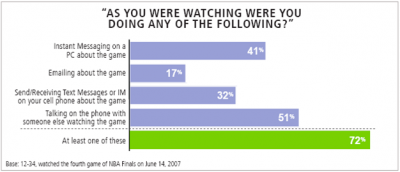
It’s one thing to read research about people texting, IM-ing, tweeting and posting on Facebook. But when I came home one night and I saw my wife Sheri watching Americ’s next top model, while texting her friend and chatting with her sister on Facebook it became real to me.
People also watch TV online. During the Beijing games, 52 million people in the US watched a video stream on NBCOlympics.com. In Europe and China even more people streamed the games online.
The point us that it’s easy for somebody to research something that catches their attention on TV. When somebody is intrigued by the destination story, a laptop or other mobile device is close by. That means a big opportunity for us to follow through on the initial awareness created through the games and encourage consumers to start the trip planning process.

Our strategy to drive people to our consumer websites during the games involves using refering links from high traffic Olympic related websites, Search Engine Otimization and Marketing, advertising and social media. I’ll highlight each one in the next few days.
-
Internet, Marketing, tourism bc
Tourism BC 2010 Online Olympics activities: #3 – exposure on 3rd party websites
The main benefit of the 2010 games from an overall marketing perspective is exposure. The TV broadcasts are (still) the priority and the travel media teams from Tourism BC and our tourism partners work with broadcasters around the world to ensure the destination message is covered to it’s maximum potential. They even have staff ’embedded’ with priority markets; an Olympic first.
There are also many people around the globe who stay connected with the games through online channels. Some call it the ‘biggest screen’ principle. When somebody doesn’t have access to a large TV screen, they’ll watch it online (at work?) or when that’s not available, on their cellphone. People also stay connected with the events by visiting the official Olympic website, a broadcaster website or their favourite news site. We want to maximize these opportunities as well.
Leveraging the exposure is core for our online activities. We’ve worked for years to build the right relationships and create win-win situations. It took me to New York to meet with the NBC Olympics team for example. By building relationships and creating win-win situations by offering ideas and support, we have maximized stories, photos and videos on the NBCOlympics website, the official 2010 games website and more.
A strong collective between city, province and country DMO’s is important. Media and sponsors don’t have time to deal with each individually and we’re pleased with the collaboration and results. Broadcasters and sponsors around the world use our B-Roll and websites contain our stories that highlight all of British Columbia and Canada.



